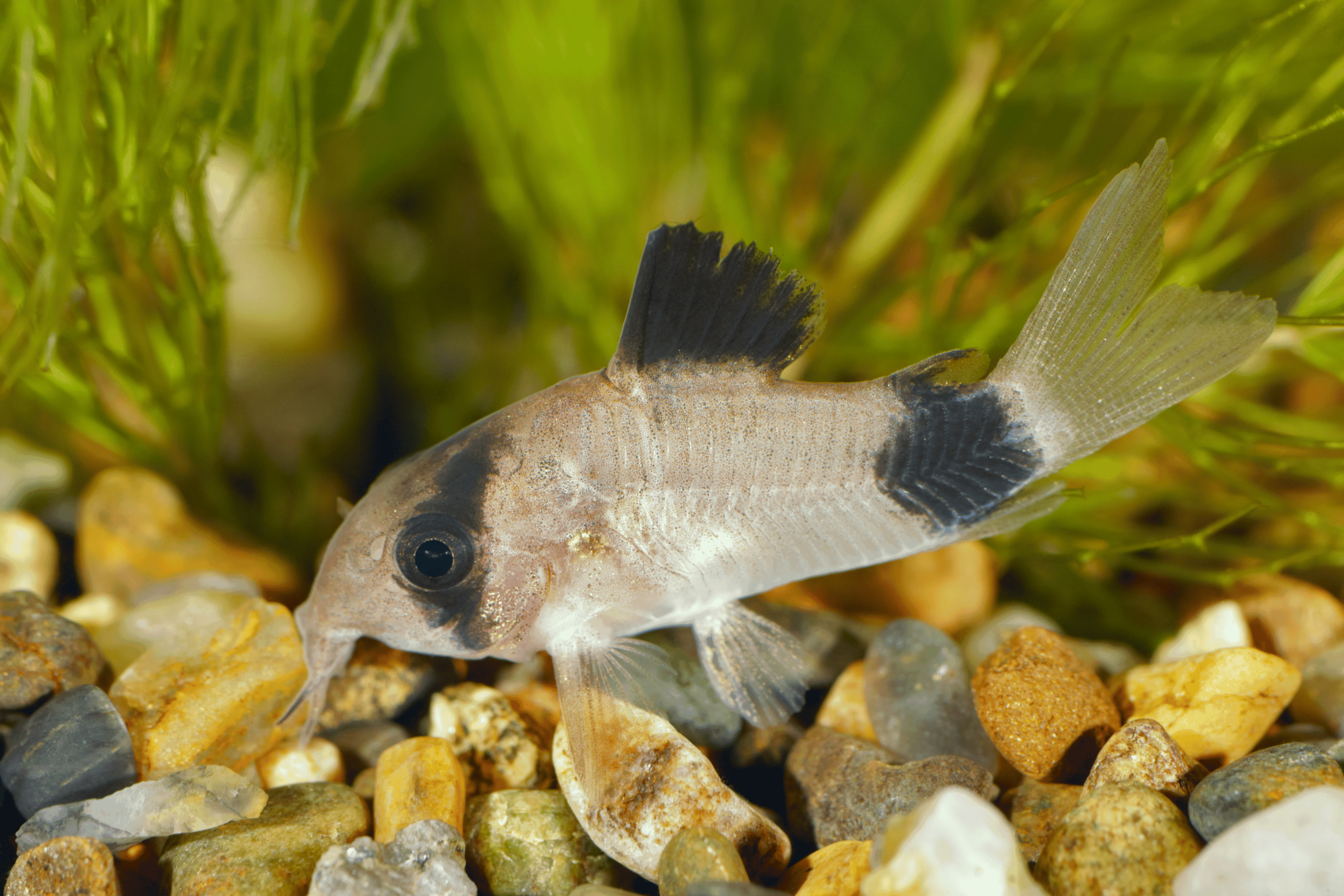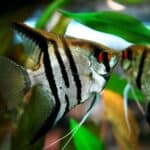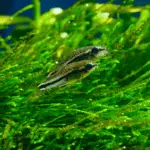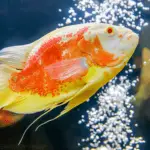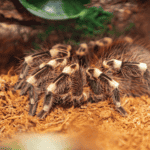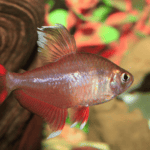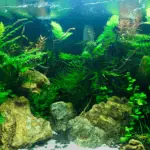Panda Corydoras are fascinating and captivating little fish that can often be found in the freshwater aquarium hobby. Hailing from South America, these small, bottom-dwelling creatures are a popular choice among both beginner and experienced aquarists. With their unique appearance, endearing social behaviors, and relatively low maintenance requirements, it’s easy to see why Panda Corydoras have earned a special place in the hearts of fish enthusiasts.
Native to the clear, slow-moving waters of the Ucayali River System in Peru, Panda Corydoras thrive in a habitat rich with sandy or fine gravel substrates, plants, and driftwood. As a highly social species, we recommend keeping them in groups to promote their overall well-being and to observe their charming interactions with one another. Throughout this article, we will explore the essential aspects of Panda Corydoras care, including tank setup, diet, and breeding, to help you create a thriving environment for your aquatic friends.
Identification and Appearance
Color
The Panda Cory, also known as the Panda Catfish, has a unique color pattern that sets it apart from other corydoras species. Their body color is mostly whitish-silver, with black patches across their eyes, similar to a panda bear’s markings, which gives them their name. They also have black markings on their lower dorsal fins and near their tail fins.
Head
Panda Corys have a flattened, broad head that is well-suited for their bottom-dwelling lifestyle. It helps them dig through the substrate in search of food. Their eyes are slightly elevated and positioned on the sides of their heads, providing a wide range of vision.
Dorsal Fin
Their dorsal fin is triangular shaped and located just behind their head. The fin is typically clear or slightly white, with a black or dark patch at the bottom. This fin helps them maintain balance in the water and navigate through their environment.
Bony Plates
Panda Corys possess bony plates, called scutes, which run along the sides of their bodies. These plates provide some protection against predators while still allowing flexibility for swimming and navigating through their environment.
Scutes
The scutes can be divided into two categories: midline and lateral scutes. Midline scutes run along the middle of the fish’s back, whereas lateral scutes cover the sides of their body. In addition to their protective function, these scutes also give the Panda Cory its distinctive ridged appearance.
Caudal Peduncle
The caudal peduncle, or the area between their anal and tail fin, is relatively thick. This thickness aids in swimming and maneuvering, giving the Panda Cory a powerful tail flick to propel them through the water.
In terms of appearance and features, Panda Corys are not only charming but also well-adapted to their environment. Their unique coloration and body structure make them an excellent choice for aquarium enthusiasts who desire a fascinating and hardy fish species.
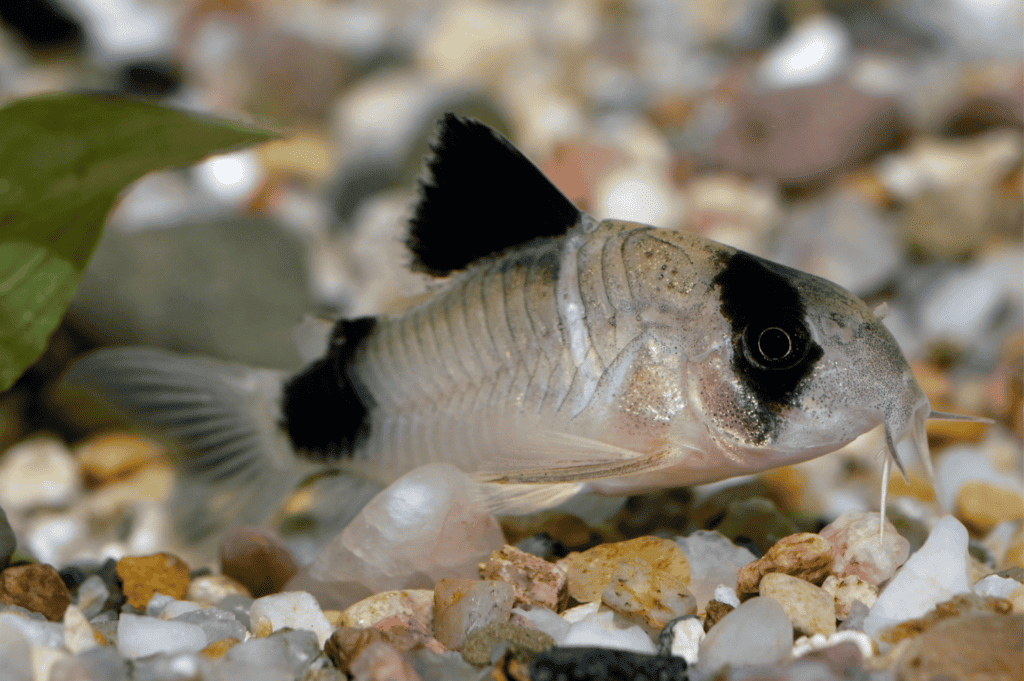
Behavior and Temperament
The Panda Corydoras possess a peaceful temperament, making them ideal tank mates for a variety of other non-aggressive fish species. As bottom-dwelling creatures, they prefer to reside on the lower levels of the tank, foraging for food and exploring the substrate.
Interestingly, these fish are social animals, known to form and maintain schools. They are most comfortable when housed in groups of six or more, and their schooling behavior can provide a delightful display for aquarists. By keeping them in groups, we encourage their natural instincts and reduce stress, ensuring a healthy environment.
In terms of activity, Panda Corydoras are mostly active during the day, although they can display bouts of activity at nighttime as well. They are frequently seen rummaging through the substrate in search of food, using their barbels to sift through sand or gravel. Additionally, they occasionally dart towards the water surface for a gulp of air, a behavior unique to certain catfish species.
While the Panda Corydoras are confident and adaptable, they do have specific requirements when it comes to the condition and setup of their tank. They prefer a well-planted and dimly lit environment, with hiding spots available for retreat. Smooth and fine-grained substrate is essential, as rough materials can damage their sensitive barbels.
Overall, understanding and accommodating the peaceful and social nature of Panda Corydoras, along with their preference for bottom-dwelling, is essential for maintaining a healthy and harmonious community tank. Their captivating behavior and endearing traits are sure to make them a popular addition to any aquarium.
Habitat and Natural Environment
Peru
In Peru, we can find panda corydoras inhabiting slowly flowing rivers and shallow waters. The natural habitat of these fish is typically characterized by a soft substrate of sand or fine gravel, where they can better use their barbels to search for food. In these areas, the water is often clear, with dense vegetation providing ample hiding spots for these bottom-dwelling creatures.
Amazon
The Amazon region is another well-known habitat for panda corydoras. Here, they share their environment with a vast number of other aquatic species. In the Amazon, the waters where these fish reside are often more acidic due to decomposing vegetation, and the water tinted brown by tannins. Nevertheless, our beloved panda corydoras adapt well to these conditions, using their barbels to navigate and find sustenance in their surroundings.
Ecuador
Lastly, in Ecuador, panda corydoras also thrive in environments similar to those of Peru and the Amazon. In this region, it’s common to find them in small tributaries where soft sand or fine gravel lines the river bottom. The dense vegetation in these bodies of water provides crucial shelter for these small fish, while their barbels remain indispensable for navigating and foraging.
In all these countries, the habitat and natural environment conditions allow panda corydoras to flourish, relying heavily on their unique features such as barbels and adaptability to thrive in the diverse aquatic ecosystems.
Care and Maintenance
Tank Size
When setting up an aquarium for Panda Corydoras, we recommend choosing a tank size of at least 20 gallons for a group of 4-6 of these fish. They do best in groups and are social creatures, so a spacious tank is essential.
Water Temperature
Panda Corydoras thrive in water temperatures between 72°F and 78°F. We recommend using a heater to maintain a stable temperature, ensuring their comfort and contributing to their overall health.
Water Quality
Maintaining water quality is vital for the well-being of your Panda Corydoras. We recommend performing regular water changes of at least 25% once a week. This helps keep ammonia, nitrite and nitrate levels in check and maintains a stable pH of around 6.5-7.
| Water Quality Parameters | Ideal Range |
|---|---|
| pH Level | 6.5 – 7.0 |
| Ammonia | 0 ppm |
| Nitrite | 0 ppm |
| Nitrate | < 20 ppm |
Water Hardness
Panda Corydoras prefer soft to moderately hard water. Aim for a hardness level of 2-12 dGH.
Lighting
Moderate lighting is suitable for Panda Corydoras. It will help maintain a natural day and night cycle for your fish without causing stress.
Oxygen
Adequate oxygenation is essential for your Panda Corydoras. We recommend providing gentle water flow with the help of a filter to ensure proper oxygen exchange.
Substrate
A soft substrate, such as sand or fine gravel, is ideal for Panda Corydoras. It allows them to dig and explore without injuring their sensitive barbels.
Decoration
To create a natural environment for your Panda Corydoras, we suggest including hiding spots, such as caves, driftwood, or plants. This encourages their natural behavior and helps them feel secure.
20-Gallon Tank
As mentioned, a 20-gallon tank should be the minimum size for Panda Corydoras. This provides ample space for them to swim, forage, and interact with one another.
Heater
A reliable heater is essential to maintain the right temperature range. Set the heater to around 75°F for optimal conditions.
Filter
A quality filter is necessary for proper water filtration and oxygenation. Choose a filter that creates gentle water flow, ensuring the best environment for your Panda Corydoras.
Diet and Feeding
As avid aquarists, we understand the importance of providing a nutritious and varied diet for our Panda Corydoras. These small catfish are omnivorous by nature, grazing on a mix of plant-based and protein-rich foods.
In their natural habitat, Panda Corydoras typically consume a wide variety of live foods. We recommend supplementing their diet with live or frozen foods such as brine shrimp, daphnia, and bloodworms. These provide essential nutrients and encourage natural foraging behaviors.
In addition to live foods, incorporating a selection of insects is also beneficial for our Panda Corydoras. In the aquarium environment, high-quality sinking pellets or wafers can be used to provide a balanced diet.
To ensure the well-being and longevity of our fish, we choose a mix of the following food types:
- Live Foods: Brine shrimp, daphnia, bloodworms
- Insects: Small larvae or insect-based sinking pellets
- Sinking Pellets/Wafers: High-quality plant-based and protein-rich options
Offering a varied diet encourages optimal health and replicates their natural grazing habits. Regularly alternating between different food types also prevents our Panda Corydoras from becoming fussy eaters. And, always remember to avoid overfeeding, as this can lead to water quality issues and other health problems.
Breeding
Breeding Tank
We recommend setting up a specific breeding tank for your panda corydoras. The ideal size is around 10-20 gallons. It’s crucial to maintain a temperature of 72-78°F, pH level between 6.0-7.0, and gentle water flow to encourage spawning. Add some hiding spots like caves, plants, and smooth rocks to mimic the panda cory’s natural environment. Providing high-quality food can also help conditioning the breeding pairs.
Separate Breeding Tank
Transferring the breeding pair to a separate breeding tank can increase their chance of successful spawning. Once the adult pair shows signs of compatibility and readiness to breed, carefully move them to the spawning tank. Ensure proper water parameters, as sudden changes can affect breeding behavior. It’s advised to remove the adult fish after spawning to prevent them from feeding on the eggs or fry.
Spawning
Panda corydoras usually spawn during the early morning hours. The female will lay adhesive eggs on the aquarium glass, plants, or other surfaces, while the male fertilizes them. Females can lay between 20-100 eggs per spawning event.
It’s crucial to monitor the water parameters during this stage. Frequent partial water changes (20-30%) can aid in ensuring a suitable environment for the eggs and fry.
Health Issues
As with any aquatic species, our panda corydoras can face a few health issues. By addressing these potential problems, we can ensure the well-being of these charming fish. In this section, we will discuss some common health issues and their causes.
Ich, or Ichthyophthirius multifiliis, is a prevalent disease affecting panda corydoras. This parasitic infection manifests as tiny white spots on the fish’s body, giving them a grain-like appearance. We can prevent Ich by maintaining a stable, clean aquarium environment. If our fish get affected, promptly raising the water temperature to 86°F (30°C) over 48 hours and treating the tank with medication will help.
Stress is another factor that can harm our panda corydoras. When pandas are under stress, they’re more susceptible to diseases and have a diminished immune response. By providing hiding spots, avoiding overcrowding, and ensuring water quality, we can minimize their stress levels.
High ammonia and nitrite levels in the aquarium can lead to health issues for our panda corydoras. These chemicals are toxic to fish and can cause damage to their gills, eventually leading to death. To prevent this issue, we must establish a proper nitrogen cycle in the tank, perform regular water changes, and avoid overfeeding. Regularly monitoring ammonia and nitrite levels with a test kit will help us determine when action is needed.
Our panda corydoras may suffer from various bacterial and fungal infections as well. Sudden changes in water parameters or having a dirty tank can trigger these issues. To prevent these infections, we must maintain a clean environment and stable water parameters, treating any affected fish with proper medication.
By carefully monitoring our panda corydoras and providing them with a stress-free, clean environment, we can prevent many health issues and enjoy watching these wonderful fish thrive in our aquarium.
Tank Companions
When choosing tank mates for our Panda Corydoras, it’s important to consider the specific needs and behaviors of these small, peaceful fish. As they thrive in a community tank environment, there are several factors we need to take into account, like tank size, compatible species, and stocking levels.
A suitable tank size for Panda Corydoras and their companions is essential. We recommend a minimum of 20 gallons for a small group of Panda Corys, as they require ample swimming space. As a general rule, we can increase the tank size as we add more tank mates.
In order to maintain a harmonious environment, we should carefully select appropriate tank mates for our Panda Corys. Ideal companions should also be peaceful and non-aggressive. Some excellent choices include schooling fish, such as:
- Danios
- Tetras
- Rasboras
These small, energetic fish can add vibrant colors and activity to the middle and upper sections of the tank, perfectly complementing the bottom-dwelling Panda Corys.
Another compatible option to consider is including Loaches as tank mates. These fish can coexist peacefully with Panda Corydoras, sharing the bottom of the tank and adding diversity to the aquarium. It is essential to research the individual species and their requirements, as some loaches can grow quite large.
For variety, we can also add moderately peaceful fish like Tiger Barbs and Gouramis to the mix. However, it’s best to observe them closely, as their temperament can vary. Ensuring they are well-fed and have plenty of hiding spots can prevent them from becoming aggressive.
Remember that each species will have specific requirements in terms of water parameters, temperature, and diet. We must pay close attention to these aspects while creating a compatible community tank that caters to the needs of our Panda Corydoras and their companions.
Aquascaping
Plants
In aquascaping, one of the main elements we focus on is plants. Placing plants in our tank not only makes it visually appealing but also contributes to the well-being of our Panda Corydoras. A popular choice is Java Moss, which can easily attach itself to various surfaces in the aquarium. Additionally, floating plants provide shade and a natural environment, making Panda Corydoras feel more at ease.
Driftwood
Driftwood is another essential element in aquascaping. We use it to create natural, visually appealing structures in our tank. It provides the Panda Corydoras with hiding spots and mimics their natural habitat. Remember to properly prepare the driftwood by soaking it or boiling it before placing it in the aquarium to prevent any unwanted changes in water chemistry.
Caves
Creating caves using rocks, clay pots, or other materials serves as an ideal habitat for Panda Corydoras to rest and seek shelter. These caves provide a sense of privacy and security, making the fish feel more comfortable in their environment. Ensure the materials used to build the caves contain no sharp edges as they could potentially injure our fish.
Rocks
Rocks add visual depth and complexity to our aquascape. When using rocks to build hiding spots for Panda Corydoras, we should ensure they are stable and will not collapse under the fish’s movement. It is also essential to rinse the rocks thoroughly, removing dirt and debris that might impact the water quality.
Roots
Incorporating roots, such as spiderwood, into our aquascape adds a natural touch and provides additional hiding spots for the Panda Corydoras. When using roots, ensure they are soaked and prepared to avoid discoloring our aquarium water. Also, take care to secure the roots to prevent them from floating and creating a hazard for our fish.
Size and Lifespan
The Panda Corydoras, a captivating member of the catfish family, is one of the smaller members of the Callichthyidae family. Their small stature makes them a popular choice for pet fish enthusiasts. In terms of size, we can expect these freshwater fish to grow to an average length of 1.5 to 2 inches (38 to 50 mm).
As scavengers, Panda Corydoras play a vital role in maintaining the cleanliness of their aquatic environment. They help sift through the substrate and search for food particles. Their hardy nature and adaptability contribute to their relatively long lifespan. In ideal conditions, we can expect them to live for approximately 5 to 10 years.
We should keep our Panda Corydoras in groups to ensure they thrive and exhibit their natural behaviors as they’re known to be sociable fish. In the wild, they are found in shoals, which is essential to remember when creating an optimal and enriching environment in our aquariums. Grouping them with at least five more of their kind encourages comfort and contributes to their overall health and longevity.
To help our Panda Corydoras reach their full potential, it’s crucial to pay attention to the water quality, providing a balanced diet, and maintaining proper tank conditions. With our care and commitment, these charming creatures can remain a delightful addition to our aquariums for many years.
Frequently Asked Questions
What is the ideal water temperature for Panda Corydoras?
The ideal water temperature for Panda Corydoras is between 72°F and 79°F (22°C to 26°C). It’s important to maintain a stable temperature within this range to ensure their comfort and wellbeing.
How long is the typical lifespan of a Panda Cory?
A healthy Panda Cory can live for 5 to 7 years when provided with proper care, a clean environment, and a balanced diet.
What is the best tank size for Panda Corydoras?
We recommend a minimum tank size of 20 gallons for Panda Corydoras. These fish are active bottom dwellers and need space to swim and explore. A larger tank will also help maintain stable water conditions.
What is the optimal pH level for Panda Corydoras?
The optimal pH level for Panda Corydoras is between 6.0 and 7.5. A slightly acidic to neutral pH is ideal for these fish, as it mimics their natural habitat.
At what age do Panda Corys start breeding?
Panda Corys usually begin breeding when they reach approximately 1 year of age. To encourage successful breeding, it’s essential to provide them with the optimal water conditions, hiding spots, and a diet that meets their nutritional needs.
Are Panda Corydoras suitable for beginner aquarists?
Yes, Panda Corydoras are suitable for beginners due to their hardy nature, relatively simple care requirements, and ability to adjust well to community tanks. However, it’s crucial to be diligent about maintaining water quality and providing a proper living environment to ensure their long-term health.
